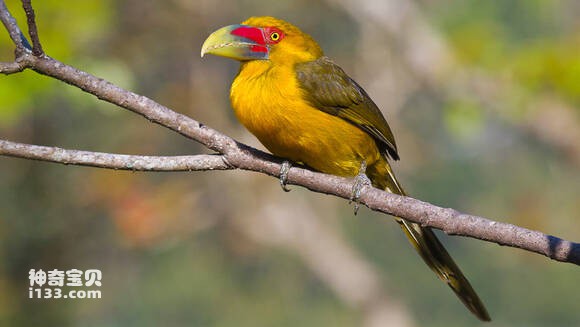Pteroglossus baillon
IUCN
LCBasic Information
Scientific classification
- name:Pteroglossus baillon
- Scientific Name:Pteroglossus baillon,Saffron toucanet
- Outline:Climbing birds
- Family:
Vital signs
- length:No textual research information is available
- Weight:No textual research information is available
- lifetime:No textual research information is available
Feature
Distribution and Habitat
It is found in South America (including Colombia, Venezuela, Guyana, Suriname, Ecuador, Peru, Bolivia, Paraguay, Brazil, Chile, Argentina, Uruguay, and the Malvinas Islands (also known as the Falkland Islands))
Appearance
The orange Toucan looks slightly like a hornbill, with a large beak, but it is lighter, serrated at the edge of the beak, and the beak length accounts for about one-third of the body length. The anterior part of the beak is yellow-green, the posterior part is red, and there are blue phase intervals. Its forehead, ear feathers, chest and abdomen are yellow, the eyes and waist are red, the pillow, back, shoulders, wings and tail are yellow-green, and the iris is bright yellow.
The yellow Toucan's beak, despite its size, weighs less than 30 grams. The structure of the mouth bone is very special, it is not a dense entity, the outside is a layer of crust, through the middle of extremely fine fibers, porous spongy tissue, filled with air, so that it does not feel heavy pressure.
Details
Orange Toucan scientific name Pteroglossus baillon, foreign name Saffron toucanet, medium-sized climbing bird.

Tangerine Toucans are gregarious and prefer to live in treetops; It is also the noisiest forest bird, capable of making loud rumbles, trumpets and screeches. Its nest is built in a hole high in a tree. When eating, always peck the food with the tip of the mouth first, then tilt the neck, throw the food upward, and then open the big mouth to accurately put the food into the throat, without having to go through the long mouth and spend time in the process of "swallowing". The orange toucan is omnivorous, feeding on fruits, seeds, and insects, and sometimes raiding the nests of small birds, eating eggs and chicks.

Orange toucans nest in tree holes. - Lay 2 to 4 eggs. Smooth white eggs are piled in unlined holes and hatch in about 16 days. The hatchlings are completely naked, take at least three weeks to open their eyes, and begin to live their lives about 45 days after hatching.
Listed in the International Union for Conservation of Nature Red List of Threatened Species (IUCN) for 2016 ver 3.1 - Near Threatened (NT).
Listed in Appendices I, II and III of the Convention on International Trade in Endangered Species of Wild Fauna and Flora (CITES) 2019 edition Appendix III.
Protect wild animals and eliminate wild meat.
Maintaining ecological balance is everyone's responsibility!








